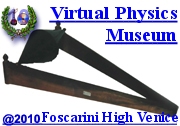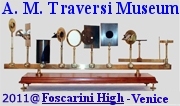
On the copyright
Facebook's page

Sign you too our
GUEST BOOK
Physics Museum
| On the copyright | The author | F.A.Q. | Managing | Contact | Opening hours | Acknowledge |
| Home page Liceo Foscarini | |||||||||
|---|---|---|---|---|---|---|---|---|---|
 On the copyright Facebook's page |
 Sign you too our GUEST BOOK | ||||||||
| The "Antonio Maria Traversi" Physics Museum | |||||||||
| A permanent exhibition, open to the public, of approximately 300 didactic and experimental instruments belonging to the Old Physics Laboratory of the Marco Foscarini High School | |||||||||
|
|||||||||
|
Welcome in the homepage of the "Antonio Maria Traversi" Physics Museum of the Marco Foscarini High School, a permanent exhibition, open to the public, of which is also available on the web:
In 1994, Liceo Marco Foscarini organized the exhibition "A Nineteenth - Century Physics Laboratory in Venice" (curators: Professors Daniela Magnanini and Andreina Naletto) which dealt with the collection of didactic and experimental instruments of the Old Physics Laboratory. This temporary exhibition marked the beginning of a long and hard project: the recovery of the ancient physics instruments of the Liceo Foscarini, one of the oldest school in Italy, as it shows the celebration of its bicentenary in 2007.
It was the hope of the headmaster of the time, Fabbri, that this initiative would provide the basis for a scientific museum in Venice. This dream has now been realized! The "Antonio Maria Traversi Physics Museum" opened its doors to the public on Saturday 20th December 2003 (curator: Pierandrea Malfi).
The museum is dedicated to Abbot Antonio Maria Traversi, this institute's first headmaster, who was an excellent physicist as well as a teacher. He was the author of a "physics text book" in 7 volumes published in two editions in 1806-1809 and 1822, both preserved in excellent state into the library of the school and used, with other books, to realize some posters hung up to the walls of the Museum's room with old physics texts (the idea belongs to prof. Daniela Magnanini).
300 physics instruments are exhibited (out of a total of 453). These are either for didactic purposes or were specifically constructed for use in scientific research carried out by teaching staff during the nineteenth century. Over 60% of the equipment exhibited is in perfect working order, as witnesses the use of some instruments during the visits and during the presentations at the school today.
The guides of the groups are a few students of the school: they have attended a formation course organized by the Museum Direction with positive result.
|
|
| Last updated 20-7-2023 | The green words are "work in progress" links. The red / red words are links to italian pages, while the normal ones follow the standard colours. The elements in red have hidden texts actived by the mouse's arrow. The brown links are used to view an immage in the gallery connected with the text. |  |
| The total or partial reproduction of this page and/or of its parts with any means is permitted only if it is not for commercial gain and all authors and Marco Foscarini School must be fully acknowledged. In the case of works on the web a link to the page or pages of the Virtual Museum or of the A. M. Traversi Physics Museum used as source must be always added. The reproduction of any picture from this page in scientific journals and/or in research papers as the publication of this page and of any data of the database need the written authorization of the Traversi Museum Direction. This authorization might be given by the Museum Direction after the presentation of a request in which the project is described. All the technical information regarding the instruments described in the virtual museum are continuously up to date. So differences between page on the web and the last data acquired can be possible. The interested are kindly request to contact the Direction of the Museum. | ||
| URL of the Virtual Museum: http://museo.liceofoscarini.it/virtuale/index.html URL of "A. M. Traversi Physics Museum": http://museo.liceofoscarini.it/museoreale/index.html; e-mail: museo.atraversi@del@liceofoscarini.it [Please delete "del@"]. | ||
| Liceo Classico "Marco Foscarini" - Venezia |